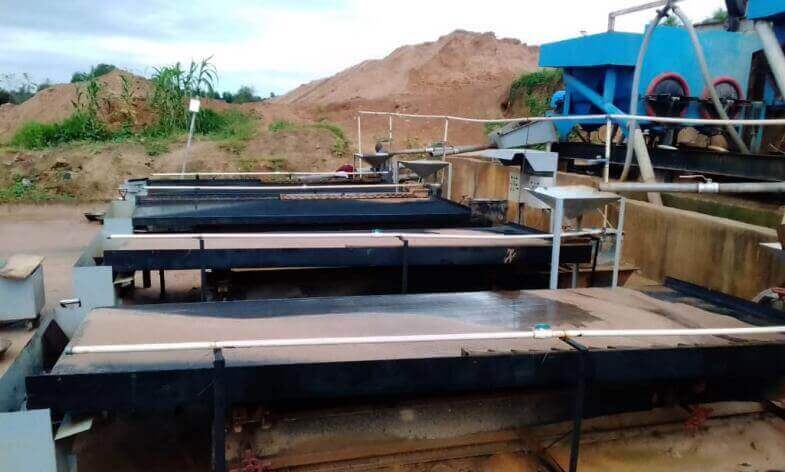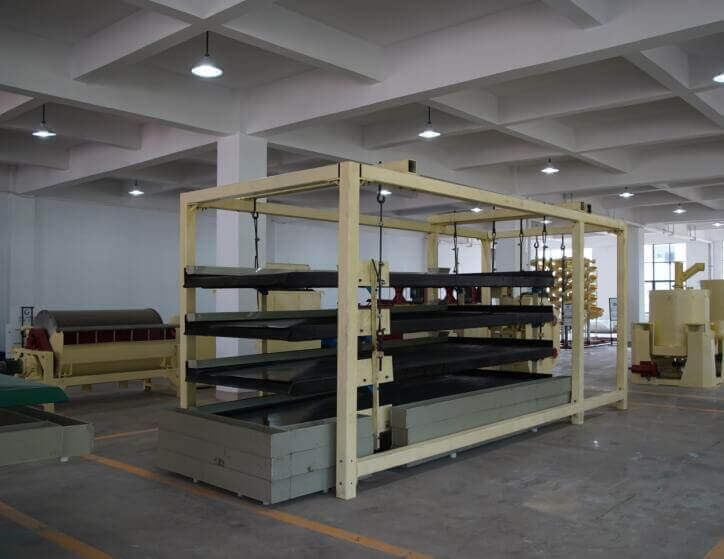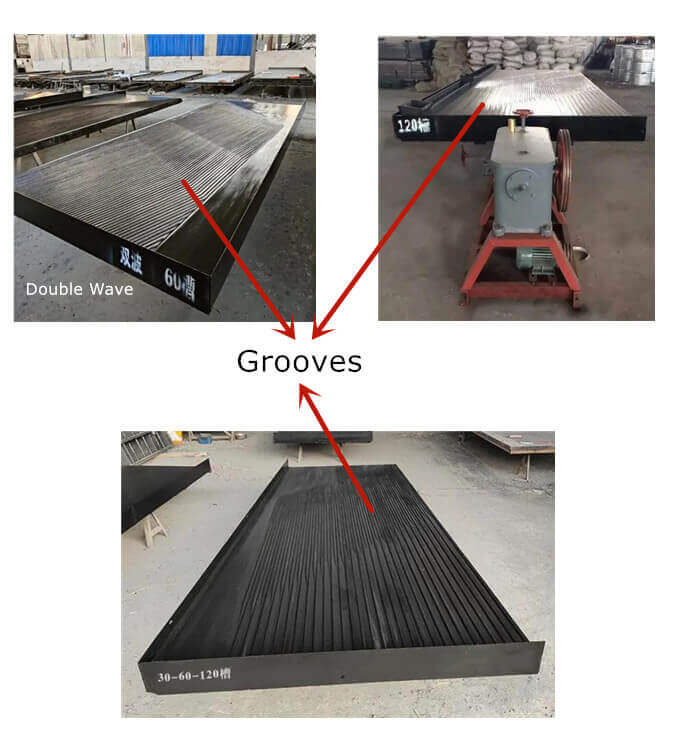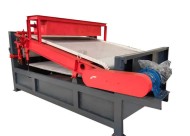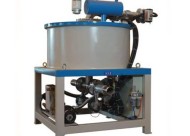Shaking tables, also known as shaking concentrators or gravity separation tables, are equipment for mineral processing and ore separation based on density, particle size, and shape differences. They are widely used in mining to separate valuable minerals from gangue or waste materials.
Shaking Table Types
There are many ways to classify shaking tables, and no unified classification method exists. Next, we will introduce the shaker according to different aspects.
- The particle size of the processed materials: Coarse sand shaker table(2-0.2mm); Fine sand shaker table(2-0.074 mm); Ore slime shaker table( 0.074 mm).
- Bedhead: Cam lever shaker, eccentric link shaker, and spring shaker.
- Processing minerals: Mineral dressing shaker, Coal preparation shaking table.
- Shaking table structure: Single-deck and multi-deck shaker tables; Floor-standing, and suspension shaking tables.
- Force field: Gravity shaking table, centrifugal shaking table.
Five Common Shaking Tables
1. 6-S Shaking Table
6-S Shaking Table, also known as 6S Gravity Shaking Table, is a widely used gravity separation equipment for mineral processing and ore separation. It is commonly used for sorting tin, tungsten, gold, silver, lead, zinc, tantalum, niobium, iron, manganese, coal, monazite, rutile, zircon, and other metallic and non-metallic minerals. The 6S shaking table effectively separates particles based on density, particle size, and shape differences.
2. Yunxi Shaking Table
Yunxi type shaker is also called Guiyang type shaker, developed from Su type CC-2 type shaker after improvement in our country. It got its name because it was originally manufactured in Guiyang factory. Yunxi Shaker adopts a simplified cam lever head called a cam rocker head. It is directly driven by the roller on the eccentric shaft to move the rocker’s arm.
The frame of the Yunxi shaker is simple, and the bed surface is supported by sliding. There are four semicircular protruding sliding blocks under the four corners of the bed surface, and concave supports in the rectangular oil bowl support the sliding blocks. Fill an oil bowl with oil. The bed surface makes a linear reciprocating motion on the slider seat. This support method is balanced in movement and can withstand greater pressure. But its movement resistance is bigger. Adopt variable axis slope adjustment mechanism.
The asymmetry of the head of the Yunxi shaker is relatively large, and it has a wide range of differential adjustments, which can adapt to different feeding particle sizes and sorting requirements. The bedside mechanism operates reliably, with few wearing parts and no oil leakage. However, it is not convenient to adjust the stroke and overhaul, and the adjustment range of the lateral slope of the bed surface is small (0-5 degrees). Therefore, the shaker is suitable for processing fine-grained materials or slimes.
3. Spring Shaking Table
The spring shaker differs from the 6-s and Yunxi shaking tables because it uses components and hard springs as the differential motion mechanism. After production practice and continuous improvement, it has been used as a finalized product.
The bed surface of the spring shaker is the same as that of the Yunxi shaker, and the groove method also makes the bed strips. The support method of the bed surface is the same as that of the Guiyang shaker, and the slope is adjusted by wedge blocks, generally adjustable by 1-4 degrees. It is suitable for the separation of ore slime.
4. Multi-deck Shaking Table
Multi-deck shaking tables have multiple decks stacked on each other, allowing for increased capacity and enhanced separation efficiency. These tables are often used for complex ore processing or when multiple stages of concentration are required.
5. Centrifugal Shaking Table
The centrifugal shaker makes the bed surface rotate while reciprocating, so as to strengthen the separation process with the help of inertial centrifugal force.
How to Choose The Shaking Table?
Shaking Table Specification & Model
To select the specification and model of the shaking table in the gravity separation process, it needs to be comprehensively judged according to the actual situation of the project, such as the original particle size of the shaking table, the processing capacity of the entire gravity separation workshop, and the actual available area on site.
- Mineral granularity
Generally speaking, for the feed particle size > 0.2mm, the coarse sand shaker is used, and when the selected particle size is 0.2~0.074mm, the fine sand shaker should be considered. The slime shaker should be used for the particle size below 0.074mm. - Processing capacity
For the shaking table, under the condition of other beneficiation conditions, the smaller the selected particle size is, the lower the processing star will be. For example, in the experiment of processing tin ore with Yunnan tin shaker, if the feeding particle size is 0.5-0.2mme, according to the above selection points, coarse sand shaker should be selected, and the actual processing capacity is 0.8~1.0th. When the feeding particle size is 0.074-0.04mm, we choose the slime shaker, and the processing capacity is only 0.2~0.3th. - Site area
As an economical and practical gravity separation equipment, the investment of the shaking table is very small and the ratio of rich ore can be more than 100 times higher than other mineral processing methods. Still, its main disadvantage is that it occupies a large area and the unit area The processing capacity of the bed surface is low. When the actual site area of the project is small, or the area of the gravity separation workshop is not large, and the single-deck shaking table cannot be placed, the multi-deck shaking table product can be selected.
Shaker Surface(Deck) Model
The number of grooves on the shaker surface is directly related to the particle size of the ore particles.
- The ore particles are large, and the number of grooves should be small and deep. The particles are fine, the grooves are more, and the depth is relatively shallow.
- The number of tanks is small and deep, the recovery rate is high, the processing capacity is large, and the enrichment ratio is low. The number of tanks is large, the recovery rate is low, the processing capacity is low, and the enrichment ratio is high.
- When selecting the model of the shaker surface, it is necessary to know the particle size of the ore particles first and choose the number of grooves on the shaker surface according to the particle size of the mineral.
- the treatment capacity, recovery rate, and enrichment ratio should be considered comprehensively in the design process. The shaker with a large processing capacity and high recovery rate is used as rougher, and the fine material after rougher selection is then selected with a targeted shaker surface.
- It is optional to select fine particles if the number of troughs is small, but the effect will be affected when the shaking table with a large number of troughs selects large particles.
- When the number of slots is large, the thickness of the ore paddle on the shaker surface should be thinner so as to have a better sorting effect.
| Deck Model | 45 Grooves | 60 Grooves | Double Wave | Single Wave | 90 Grooves | 110 Grooves | 120 Grooves Three Sections | 120 Grooves Second Sections | 136 Grooves |
| Advantage | Large processing capacity, obvious effect on large particle ore | Targeted | High recovery rate | The relatively low recovery rate of double wave | Targeted | Targeted | Low requirements on ore particle size, wide application range | Low requirements on ore particle size, wide application range | Effective on fine particles |
| Shortcoming | Low enrichment ratio | / | Slow grade improvement, a large amount of medium ore | Compared with the double-wave grade, the grade increases rapidly, and there are few ores in the middle mining area | / | / | Not targeted | Compared with the three sections, it is more targeted | The effect on rent particles is not obvious, and the processing capacity is relatively small |
| Applicable Particles | 1-5mm | 1-60 mesh | 1-120 mesh | 1-120 mesh | 60-80 mesh | 80-120 mesh | 1-120 mesh | 60-120 mesh | 200 mesh |
LATEST PRODUCTS
Heavy Plate Feeder
Capacity: 100-240 m3/h Power: 15-45 kW Speed: 0…
Plate Magnetic Separator
【Capacity】8-35 t/h 【Power】1.5-3 kW 【Applic…
Slurry Magnetic Separator
【Capacity】10-100 m3/h 【Feeding Material Densi…






